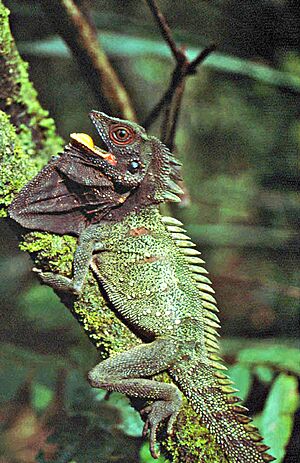Crowned forest dragon facts for kids
Quick facts for kids Crowned forest dragon |
|
|---|---|
 |
|
| Lophosaurus dilophus; Lakekamu Basin, Papua New Guinea. | |
| Conservation status | |
| Scientific classification | |
| Genus: |
Lophosaurus
|
| Species: |
dilophus
|
The crowned forest dragon (scientific name: Lophosaurus dilophus) is a large lizard. It is also called the Indonesian forest dragon. This amazing lizard lives in trees. You can find it in New Guinea and the Moluccan islands of Indonesia.
Contents
What Does the Crowned Forest Dragon Look Like?
This lizard is quite large. It has a short tail. Its back scales are a mix of different sizes. It also has a crest (a line of scales) along its spine. This crest is not continuous.
Below its ear opening (called the tympanum), it has some slightly larger scales. There is also a row of big scales under its jaw. On the front edge of its throat pouch, it has a series of large, spear-shaped scales.
This dragon looks different from other similar lizards. For example, it does not have large, cone-shaped scales below its ear opening like the Boyd's forest dragon. It also differs from the southern forest dragon. The crowned forest dragon has spear-shaped scales on its neck and back crests. The southern forest dragon has triangular ones.
Where Do Crowned Forest Dragons Live?
You can find this species in Papua New Guinea and the Moluccan Islands in Indonesia. They live all over the island of New Guinea. However, they usually do not live higher than 800 meters (about 2,625 feet) above sea level.
They have been seen on several islands. These include Aru and Kei in the Moluccas. They are also on Batanta and Salawati in West Papua Province. Other locations are Numfoor and Yapen in Papua Province, Indonesian New Guinea. They also live on Fergusson Island in Milne Bay Province, Papua New Guinea.
These lizards prefer rainforests. They are probably not found in the southern grasslands called the Trans-Fly. No records show them living there.
What is Their Home Like and What Do They Eat?
Crowned forest dragons live in rainforests. These can be lowland or mid-mountain forests. They live in both untouched forests and areas where forests are growing back. They can even live in farms or gardens if there are enough trees.
These lizards are omnivorous. This means they eat both plants and animals. Their diet includes insects and small fruits. They are also arboreal, which means they spend most of their lives in trees.
How Are Crowned Forest Dragons Protected?
Rainforests in Papua New Guinea are being cut down. This happens for logging and to create farmland. However, the crowned forest dragon is found in many places. It can also live in areas where the habitat has changed a bit. Because of this, they are not in immediate danger.
Sometimes, these lizards are traded. A small number are sold from Papua Province in Indonesian New Guinea. This species is not listed by CITES. CITES is an agreement that protects endangered animals. It is also not legally protected in Indonesia. But the small amount of trade does not seem to harm the wild populations.


